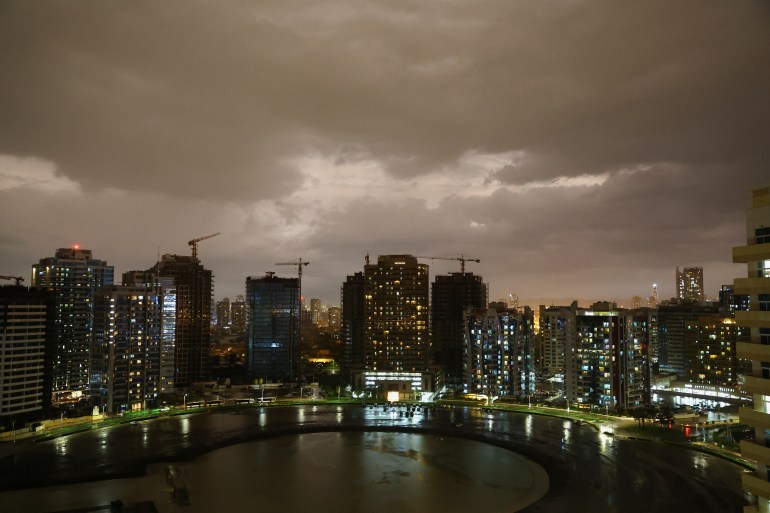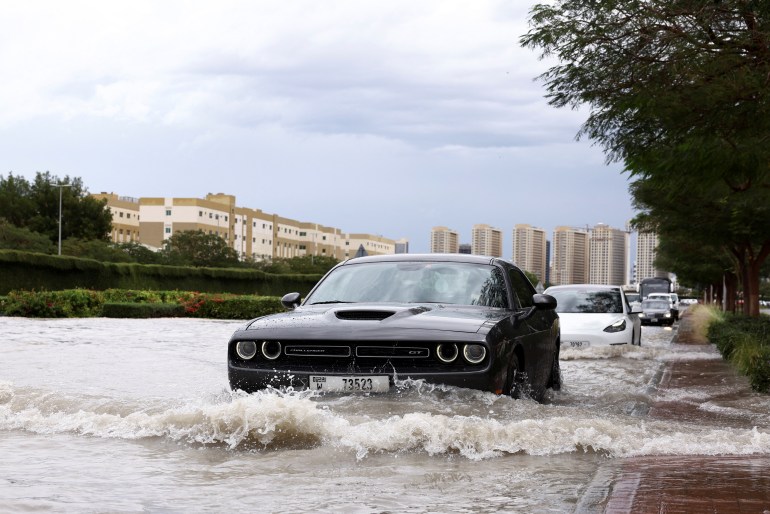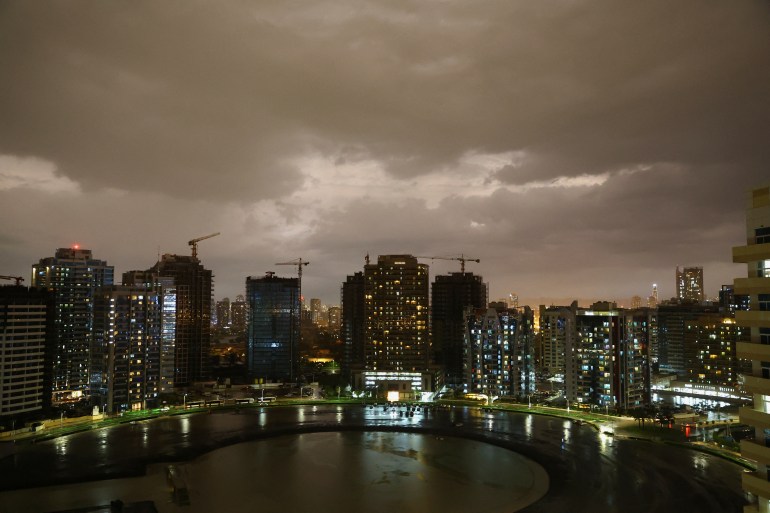The United Arab Emirates (UAE) was inundated with water on Tuesday after storms dumped more than a year and a half’s rain in just a few hours, flooding roads as well as the international airport based in the metropolis of Dubai.
Neighbouring Oman also witnessed heavy rains and flooding that killed at least 20 people.
Speculation was rife on social media, linking cloud seeding, which involves the manipulation of existing clouds to induce rain, to the unprecedented precipitation. But experts say the record rainfall was likely caused by climate change.
Here is what we know about the reasons behind the record rainfall and subsequent flooding in the UAE and Oman.
What happened in the UAE and Oman?
The storm had initially hit Oman on Sunday before it pounded the UAE on Tuesday, knocking out power and causing flight disruptions. The deluge inundated houses, caused traffic chaos and trapped people in their homes in Dubai.
The UAE witnessed the heaviest rainfall on record, authorities said.
The state-run WAM news agency called it “a historic weather event” that surpassed “anything documented since the start of data collection in 1949.” That’s before crude oil was discovered in the energy-rich Gulf country.
By the end of Tuesday, more than 142mm (5.59 inches) had soaked Dubai – home to more than three million people. Close to 127mm (5 inches) of rain fell at Dubai International Airport, where about 76mm (3 inches) of rain is normal in an entire year.
According to authorities Oman received around 230mm (9 inches) of rain between Sunday and Wednesday. The average rainfall in the capital, Muscat is about 100mm (4 inches) per year. Bahrain, Qatar and Saudi Arabia also witnessed rains.

What fueled the speculation that blamed cloud seeding for the rains in Dubai?
Reports quoted meteorologists at the UAE’s National Centre for Meteorology (NCM) as saying Dubai flew six or seven cloud-seeding flights before the rains started. Flight-tracking data analysed by The Associated Press news agency also showed one aircraft affiliated with the UAE’s cloud-seeding efforts flew around the country on Monday.
Cloud seeding, which was initiated in the 1990s, has been a part of the country’s effort to solve water shortages.
According to reports, the NCM on Wednesday said the seeding took place on Sunday and Monday, and not on Tuesday.
Omar Al Yazeedi, deputy director general of the NCM, told the NBC news agency that the organisation “did not conduct any seeding operations during this event”.
“One of the basic principles of cloud seeding is that you have to target clouds in its early stage before it rains, if you have a severe thunderstorm situation then it is too late to conduct any seeding operation,” he added.
Rainfall is rare in the UAE and elsewhere on the Arabian Peninsula, which is typically known for its dry desert climate. Summer air temperatures can soar above 50 degrees Celsius (122 degrees Fahrenheit).
The UAE and Oman also lack drainage systems to cope with heavy rains and submerged roads are not uncommon during rainfall.
Did climate change cause the torrential rainfall?
Experts and officials have debunked the speculations that cloud seeding caused the rainfall.
“If that occurred with cloud seeding, they’d have water all the time. You can’t create rain out of thin air per se and get 6 inches [152.4mm] of water,” said Ryan Maue, former chief scientist at the US National Oceanic and Atmospheric Administration.
The deluge was likely due to a normal weather system that was exacerbated by climate change, experts say.
Global warming has resulted in “extraordinarily” warm water in the seas around Dubai, where there is also very warm air above, said Mark Howden, director at The Australian National University’s Institute for Climate, Energy and Disaster Solutions.
“This increases both potential evaporation rates and the capacity of the atmosphere to hold that water, allowing bigger dumps of rainfall such as what we have just seen in Dubai.”
According to reports, the intense downpours were a result of a slow-moving storm that moved across the Arabian Peninsula and into the Gulf of Oman over several days. This storm transported abundant tropical moisture from near the equator and released it heavily over the region.
The storm also appeared in forecast models days in advance.
Huge tropical storms like this “are not rare events for the Middle East”, said University of Reading meteorology professor Suzanne Gray. She cited a recent study analysing nearly 100 such events over the southern Arabian Peninsula from 2000 to 2020, with most in March and April, including a March 2016 storm that dropped 9.4 inches (almost 240mm) on Dubai in just a few hours.
Today’s extreme rain event in Dubai was clearly associated with a synoptic configuration that increased the odds of excessive rainfall.
A slow-moving, positively tilted trough with a strong plume of moisture transport led to record high PWAT for April: https://t.co/vL3ZAbqkIH pic.twitter.com/Opoc8B8mRP
— Tomer Burg (@burgwx) April 17, 2024
Climate scientists say that rising global temperatures, caused by human-led climate change, is leading to more extreme weather events around the world, including intense rainfall.
“Rainfall from thunderstorms, like the ones seen in UAE in recent days, sees a particular strong increase with warming. This is because convection, which is the strong updraft in thunderstorms, strengthens in a warmer world,” said Dim Coumou, a professor in climate extremes at Vrije Universiteit Amsterdam.
What is cloud seeding?
Cloud seeding is a type of weather modification process that normally tries to increase the rain or snow.
Cloud droplets don’t form spontaneously. For moisture to condense, it needs a surface to cling to. Within a cloud, there are tiny particles in the air called condensation nuclei, which provide a base for moisture to attach to.
Cloud seeding uses planes and ground-based cannons to shoot particles into clouds making more nuclei, attracting moisture. Once enough droplets merge, they become heavy and fall to Earth as rain or snow.
Small particles such as dust and dirt often play a key role in cloud formation and precipitation by providing surfaces for moisture to condense. Silver iodide can potentially serve the same function. Other substances, such as dry ice, may also be used for similar purposes.
The method, pioneered in the 1940s, can’t create water from a clear sky – particles must be shot into a cloud that already holds moisture to get it to fall, or to fall more than it otherwise would naturally.

Cloud seeding is still controversial in the weather community, mostly because it has been hard to prove that it does very much, and it’s also unclear the negative impact it might have.
Governments in drought-stricken regions like the Western United States and the UAE have invested in technologies such as seeding in the hopes of generating rain.
About 50 countries including the US, China, Australia, UEA, Germany, India, Malaysia, Russia and Mexico employ cloud seeding.
The US Bureau of Reclamation spent $2.4m last year on cloud seeding along the over-tapped Colorado River. Utah recently increased its seeding budget by tenfold.
China frequently uses seeding for irrigation. It also used it during the 2008 Olympics in Beijing with the goal of keeping the skies clear.

Read More: World News | Entertainment News | Celeb News
Aljazera









